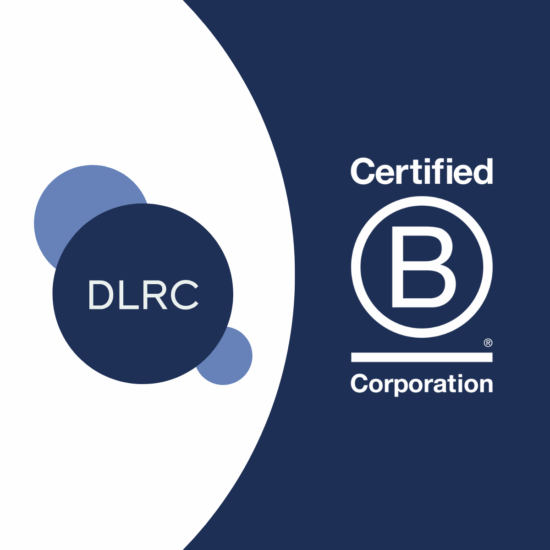Press Release: DLRC Group Becomes a Certified B Corporation
Published Dec 02, 2025
Published 29th July 2025

Drug development is rapidly evolving with new technologies, shifting regulations, and growing ethical expectations. New drugs and devices must undergo nonclinical testing to assess safety and efficacy. These are guided by health authority frameworks such as the US Food and Drug Administration (FDA), European Medicines Agency (EMA) and International Council for Harmonisation (ICH) frameworks. Traditionally, this has meant a standard mix of in vitro assays and in vivo animal tests. However, the industry is moving to reduce reliance on animal models in favour of lower-order species and non-animal alternatives. This is particularly relevant for newer therapies that target human-specific genes or pathways not found in animals. This makes traditional models less relevant and drives the push toward more human-relevant testing strategies.
Regulators worldwide are increasingly recognising the scientific value and ethical advantages of New Approach Methodologies (NAMs) as alternatives to traditional animal testing. Regulatory frameworks are evolving to accommodate these innovative approaches. Both the FDA and EMA are establishing pathways for their implementation in drug development and safety assessment. This evolution represents a significant shift in how we evaluate the safety and efficacy of pharmaceuticals and chemicals. We are moving toward more human-relevant, mechanistic, and efficient testing paradigms.
The FDA and EMA have begun to facilitate the inclusion of NAMs in regulatory submissions by announcing specialised support for developers and revised guidance. The FDA has announced that NAM data is now welcome within Investigational New Drug (IND) applications. The EMA has several types of support available for incorporation of NAM data in applications. This shift in attitude is in line with the principles of the 3Rs: replacement, reduction, and refinement of the use of animals within drug development. Although the 3Rs and the surrounding framework have been embedded in regulations and legislation for some time now, the breakthrough of NAMs will particularly accelerate the ‘Replacement’ aspect of the initiative.
For drug developers planning their nonclinical strategy, and for regulatory affairs teams, this is a clear signal that NAMs are gaining traction. While not yet the universal standard, their growing acceptance by regulators signals a clear shift. Staying informed about these evolving pathways can support more efficient and science-driven submissions.
New Approach Methodologies (NAMs) refer to innovative methods and strategies used to assess the safety and efficacy of chemicals and pharmaceuticals without relying on tests in live animals. These approaches aim to provide more human-relevant, mechanistic, and high-throughput alternatives to traditional animal-based efficacy and toxicity studies. NAMs encompass a diverse array of technologies and approaches that are collectively driving change within drug development.
In vitro systems are central to NAMs, offering controlled environments to study cellular responses to chemicals and drugs. These models use primary cells, immortalised cell lines, and stem cell-derived organoids to evaluate:
Human hepatocyte cultures, especially when co-cultured with non-parenchymal cells, are instrumental in modelling drug-induced liver injury (DILI). They provide insights into mechanisms like oxidative stress, mitochondrial dysfunction, and bile acid transport inhibition, that may be more directly relevant to human outcomes than traditional animal models.
In this section, we describe some of the key NAM technologies that are contributing important scientific data to drug development. These include organ-on-a-chip systems, in silico modelling, omics technologies and adverse outcome pathways.
Microphysiological Systems (MPS), commonly known as organs-on-chips, represent a significant advancement in NAM technology. These sophisticated platforms combine human cells with microfluidics and three-dimensional scaffolds to mimic organ function with remarkable fidelity. Examples include:
These platforms are increasingly used in multi-organ configurations to study systemic effects, drug-drug interactions, and pharmacokinetics in a human-relevant context. By enabling dynamic flow, shear stress, and tissue-tissue interfaces, MPS creates microenvironments that more accurately reflect human physiology. Liver-on-a-chip systems for evaluating drug-induced liver injury and heart-on-a-chip platforms for cardiotoxicity assessment exemplify how these technologies can replicate complex organ functions in controlled laboratory settings.
In silico models leverage computational power to predict toxicity and pharmacological properties without biological testing. Quantitative Structure-Activity Relationship (QSAR) models analyse molecular structures to predict potential toxicity. Physiologically Based Pharmacokinetic (PBPK) modelling simulates how drugs are absorbed, distributed, metabolised, and excreted in the human body. Increasingly, machine learning and AI-based prediction models are enhancing the power and accuracy of these computational approaches. This enables more sophisticated hazard identification and risk assessment.
Omics technologies provide system-wide molecular profiles that can identify biomarkers, elucidate mechanisms of action, and classify chemicals based on their molecular responses. Common platforms include:
These approaches generate rich datasets that support mechanistic understanding of toxicity pathways. Integration of multi-omics (e.g., toxicogenomics) supports mode-of-action analysis and enhances the predictive power of NAMs.
Adverse Outcome Pathways (AOPs) provide mechanistic frameworks that link molecular initiating events (e.g., receptor binding) to adverse outcomes at the organism or population level (e.g., cancer, neurotoxicity). By mapping these causal relationships, AOPs enable weight-of-evidence approaches and guide the selection of appropriate test methods. These conceptual frameworks help organise existing knowledge and facilitate the integration of different NAM approaches into cohesive testing strategies.
For specific applications like Developmental and Reproductive Toxicity (DART) testing, AOP-based approaches enable more targeted assessment of critical developmental processes and potential disruptions. This is augmented by Artificial Intelligence (AI), which increasingly contributes to AOP development by deriving pathways from diverse evidence sources. Machine learning algorithms can analyse published literature, experimental data, and existing AOPs to identify new relationships and refine understanding of toxicity mechanisms.
This data-driven approach accelerates the development of comprehensive AOPs that can guide regulatory decision-making and NAM implementation in various contexts.
Artificial intelligence (AI) is playing an increasingly pivotal role in the evolution of NAMs. By enabling advanced data integration and interpretation, AI supports the development of predictive models that enhance the reliability and efficiency of non-animal testing strategies. AI algorithms can synthesise diverse data types, including omics, imaging, and chemical structure data. This can generate insights that may not be readily apparent through traditional analysis. These capabilities are particularly valuable in areas such as in silico toxicology, automated image analysis for high-content screening, and the integration of multiomics data for systems-level toxicological assessments.
Data generated by NAMs offers clear benefits over traditional animal testing, especially when it comes to relevance to human biology and understanding how chemicals cause harm. NAMs often use human cells, tissues, or computer models. This helps produce results that are more directly applicable to people and avoids the uncertainty of translating findings from animals to humans. While animal studies are still useful for looking at long-term and whole-body effects, they often don’t explain how a chemical causes harm and may not accurately reflect human responses.
For example, during the development of the antiviral drug candidate fialuridine, nonclinical studies in mice, rats, dogs, and monkeys showed no significant toxicity. However, when given to humans during clinical trials, fialuridine caused severe liver failure and even deaths. The animal models failed to predict this because the toxic effects were related to mitochondrial damage in human liver cells. This was a mechanism that wasn’t captured well in the animal species tested. This case demonstrated how differences in species biology can lead to misleading safety results. It also highlighted the importance of human-relevant methods, such as NAMs using human cells or tissues, to better identify potential risks before clinical use.
NAMs, also support faster, more targeted safety testing by allowing high-throughput screening and making it easier to analyse large sets of data. For example, the ERα BG1Luc Oestrogen Receptor Transactivation Assay is a high-throughput, cell-based NAM that detects the estrogenic activity of chemicals by measuring their ability to activate oestrogen receptor alpha (ERα). Using human ovarian carcinoma cells engineered to express a luciferase reporter gene under oestrogen-responsive control, the assay quantifies receptor activation through luminescent signals.
Accepted under OECD Test Guideline 457 and widely used in programs like the US Environmental Protection Agency’s Endocrine Disruptor Screening Program, this assay provides human-relevant mechanistic data that support chemical prioritisation and regulatory decisions. A notable example is bisphenol A, which showed strong ERα agonist activity in this assay, contributing to its restriction in consumer products due to endocrine disruption concerns. The assay’s high-throughput format and regulatory acceptance make it a key component of modern safety assessment frameworks.
NAMs mark an important move toward safety testing that is more relevant to humans and more efficient. By focusing on how chemicals cause harm and using human-based models, NAMs address many of the shortcomings of traditional animal studies. This reduces uncertainty and allows for better predicting effects in people. Their ability to quickly test large numbers of chemicals and provide detailed information helps regulators prioritise and make smarter decisions. However, because NAMs produce different types of data and measure different effects compared to animal tests, regulatory systems need to adapt to accept NAMs as complementary or alternative evidence in decision-making.
Health authorities are increasingly confident in specific NAM technologies, with several technologies now gaining regulatory acceptance. As scientific validation grows, guidelines are evolving. Programs like the EMA’s voluntary submissions, described below, are encouraging data sharing to boost trust in these innovative methods.
Currently, several NAM technologies have achieved varying levels of regulatory validation and acceptance (see later in this article).
In April, the FDA announced that it would be phasing out animal test requirements for monoclonal antibodies and other drugs, encouraging the use of NAMs. Technologies such as in silico models, AI, organoids, and organ-on-chip. are now welcome in IND application. This is especially true when backed by real-world evidence from established markets. Updated guidance aims to streamline reviews and speed up approvals.
Similarly, the European Medicines Agency has implemented several mechanisms to support developers incorporating NAM data in submissions. These include briefing meetings within the Innovation Task Force, which provide informal discussions for innovative medicines and novel methods; Scientific Advice from the Scientific Advice Working Party for those considering NAM use in clinical trial applications or marketing authorisation applications; CHMP Qualification for developers with robust data seeking positive qualification; and voluntary data submission programs that contribute to the EMA’s understanding of NAMs and build confidence in these novel approaches. These initiatives collectively demonstrate a regulatory commitment to advancing alternatives to traditional animal testing while maintaining rigorous safety standards.
NAMs offer several scientific advantages that are directly relevant to regulatory decision-making:
While NAMs hold significant promise, several limitations must be addressed to support broader regulatory acceptance:
While animal studies remain valuable for capturing systemic and chronic effects, NAMs excel in high-throughput screening, mechanistic clarity, and integration of complex datasets through tools like artificial intelligence. However, challenges remain in modelling whole-body responses and chronic exposures. This underscores the importance of continued validation and standardisation to support regulatory confidence and broader adoption.
| Aspect | New Approach Methodologies (NAMs) | Traditional Animal Models |
|---|---|---|
| Scientific Relevance | Often more human-relevant (e.g., human cells, tissues, AI models) | May lack human-specific targets or pathways |
| Complexity of Biological Systems | Limited in modelling multi-organ/systemic interactions | Can replicate whole-body responses |
| Predictive Accuracy | High for specific endpoints (e.g., skin irritation, hepatotoxicity); improving with AI integration | Variable; often poor translation to human outcomes |
| Validation & Regulatory Acceptance | Requires extensive validation and benchmarking; still evolving regulatory frameworks | Well-established and widely accepted by regulators |
| Ethical Considerations | Aligns with 3Rs (Replace, Reduce, Refine); avoids animal use | Raises ethical and sustainability concerns, increasing societal pressure to reduce use |
| Cost & Time Efficiency | Potentially faster and cheaper for early-stage screening | Expensive and time-consuming |
| Scalability | Highly scalable (e.g., high-throughput screening, in silico simulations) | Limited scalability due to cost, logistics, and ethical constraints |
| Use in Rare Diseases | Valuable where animal models don’t exist or are impractical | Often not feasible due to low incidence and lack of suitable models |
| Infrastructure Requirements | Requires advanced lab setups, computational tools, and trained personnel | Requires animal housing, care, and compliance infrastructure |
| Regulatory Risk | Higher uncertainty: fewer precedents for approval based solely on NAMs | Lower risk due to established precedents |
Despite notable scientific progress, several key factors currently delay the widespread regulatory acceptance of New Approach Methodologies (NAMs). For regulatory affairs professionals, understanding these barriers is essential to shaping effective strategies for integration and policy evolution.
A primary challenge has been the historical lack of clearly defined regulatory use cases for NAMs during their early development. Without specific acceptance criteria or guidance on regulatory applicability, developers have faced uncertainty in aligning NAM innovations with existing regulatory expectations. This ambiguity has discouraged investment in NAM development and validation, as the pathway to regulatory acceptance remains fragmented and resource-intensive.
Another significant barrier lies in the reliance on traditional animal studies as the benchmark for validating NAMs. Regulatory frameworks often require NAMs to demonstrate predictive equivalence to animal models, despite the fact that many animal tests were never empirically validated for human relevance. This creates a circular validation problem, where new methods must conform to legacy standards that may not accurately reflect human outcomes. High-profile clinical failures of drugs that performed well in animal models underscore the limitations of this approach.
Cultural and educational factors also play a role. Many regulators and scientists have been trained primarily in animal-based methodologies. They may lack familiarity with the interpretation and application of NAM data. This knowledge gap, combined with institutional conservatism and risk aversion, contributes to slow uptake. Furthermore, legislative and regulatory frameworks in many jurisdictions still mandate animal testing for specific endpoints, even when scientifically valid alternatives exist.
Most fundamentally, regulatory data requirements have been historically structured around animal-based study designs. Test guidelines often specify endpoints and methodologies that NAMs cannot replicate directly. As a result, even scientifically robust NAMs may be excluded from consideration unless regulatory frameworks are updated to accommodate alternative data types and evidence streams.
Lastly, economic and operational barriers remain significant obstacles to the regulatory adoption of NAMs. High initial investment costs for infrastructure, validation, and workforce training can deter implementation, particularly for smaller organisations and those in resource-limited settings. The need for dual testing during transitional phases further increases the financial burden. Limited incentives, lack of harmonised validation criteria, and uncertainty around regulatory acceptance compound the challenge.
Addressing these barriers will require clearer regulatory pathways, targeted funding mechanisms, and policy reforms that recognise the long-term value of NAMs in improving human relevance and reducing reliance on animal testing.
To support broader implementation, regulatory professionals can play a pivotal role by advocating for clearer regulatory pathways, harmonised validation criteria, and policy reforms that recognise the value of NAMs beyond direct comparability to animal models. Encouraging the development of economic incentives, such as grants, tax credits, or regulatory fast-tracking for NAM-based submissions, could also help offset upfront costs and stimulate innovation. Ultimately, aligning regulatory frameworks with the evolving scientific and economic landscape will be essential to unlocking the full potential of NAMs in a sustainable and equitable manner.
Traditional validation frameworks built around animal tests are no longer fit for purpose in the age of NAMs. As the scientific landscape shifts, new approaches to validation are emerging that focus on human biological relevance and context-specific use rather than the more traditional approach of comparison to animal data.
To replace an animal test, a NAM must match or exceed it in sensitivity, predictive power, and quality assurance. For example, for FDA approval, it must be fit for purpose, show strong human-relevant predictive value, be reproducible, and meet high quality control standards. While this comparison is often benchmarked against animal models, the focus is shifting toward performance in human-relevant contexts.
The 2022 ALTEX paper outlined five essential elements for establishing scientific confidence in NAMs: fitness for purpose, human biological relevance, technical characterisation, data integrity and transparency, and independent review. This framework, utilising validation-related terms and their definitions as outlined in OECD Guidance Document No. 34, reflects the need to assess NAMs not as novel technologies, but as novel solutions to regulatory challenges, requiring modern, fit-for-purpose evaluation tools.
Fitness for purpose is foundational; NAMs must be clearly linked to the specific regulatory questions they need to answer and different methods may require different types of evidence. Precise scoping allows for more efficient validation and smarter regulatory decisions. Rather than extrapolating from animals, NAMs are now judged by how well they reflect human biology. This means using real-world human data, relevant cell types, tissue models, and metabolite pathways. A NAM that aligns closely with human outcomes is more valuable than one that only matches animal results. By prioritising human relevance, these frameworks align with the fundamental goal of safety assessment: protecting human health.
This shift is fuelling momentum behind Next Generation Risk Assessment (NGRA). NGRA’s are a forward-thinking framework that uses NAMs to better protect people, not just predict harm. Providing a workflow, NGRAs integrate all types of information, relying mainly on NAM. They encourage balanced risk decisions that safeguard health without stifling innovation through unnecessary regulatory burden.
As confidence grows in NAMs, validation is evolving to match their potential. By prioritising human relevance and regulatory context, these frameworks lay the groundwork for faster, safer, and more human-centric safety assessments. To support the integration of NAMs into regulatory frameworks, both the FDA and EU have developed searchable databases that track the progress and acceptance of NAMs.
FDA’s CDER & CBER Drug Development Tool (DDT) Qualification Project Search Enables users to explore NAMs by:
EU’s Tracking System for Alternative systems towards Regulatory acceptance (TSAR) Provides:
These tools help sponsors and researchers identify validated NAMs, understand regulatory expectations, and plan submissions more effectively.
As regulatory affairs professionals, DLRC stays ahead by actively tracking drug approvals, emerging literature, and validated NAMs. Numerous NAMs have achieved varying levels of regulatory acceptance across different application domains. This demonstrates the practical implementation of these innovative approaches in safety assessment. The following examples highlight NAMs that have successfully navigated regulatory pathways and gained acceptance for specific contexts of use.
| Use Case | NAMs Used | Outcome or Regulatory Status |
|---|---|---|
| Ubrogepant (for migraine) | 3D hepatic spheroid in vitro models; Proprietary in silico analysis system (SimPops™) | Predicted reduced liver toxicity; validated in human trials; supported NDA approval |
| High-Dose Naloxone Autoinjector (for fentanyl overdose) | In vitro and in silico quantitative systems pharmacology approach | No animal studies submitted; NDA approval based solely on NAMs |
| IL-2 Luc Assay | In vitro assay measuring immunotoxic effects on T lymphoblastic cells | Accepted in USA and Europe (2023) |
| Endotoxin Testing Alternatives - Recombinant Factor C (rFC) | Synthetic alternative to horseshoe crab blood | Recognised by European and US Pharmacopoeia |
| Endotoxin Testing Alternatives - Monocyte Activation Test (MAT) | Uses human blood cells to detect pyrogens | Recognised by European and US Pharmacopoeia |
| Eye Irritation Testing | In vitro models (EpiOcular™, SkinEthic™ HCE); Ex vivo models (BCOP, ICE tests) | Some adopted into OECD guidelines |
| Skin sensitisation | Direct Peptide Reactivity Assay (DPRA), h-CLAT | OECD TG 442 series |
| Eye irritation | BCOP, EpiOcular™ | OECD TG 437, 492 |
| Hepatotoxicity | HepaRG assays, liver-on-chip | Used in early drug screening |
| Cardiotoxicity | iPSC-derived cardiomyocytes, heart-on-chip | Integrated in safety pharmacology |
| DART | Zebrafish embryo assay (partial), stem-cell embryoid bodies | Under exploration (e.g., ICH S5(R3)) |
Adopting a science-led regulatory strategy that integrates New Approach Methodologies (NAMs) goes far beyond reducing animal testing. It enhances scientific rigour, streamlines development, and aligns with global ethical standards.
NAMs directly support the 3Rs – Replacement, Reduction, and Refinement by:
With high-throughput capabilities, NAMs accelerate early hazard identification, reduce late-stage failures, and cut costs, making them a strategic asset in modern drug development. NAMs also refine in vivo studies, guiding dose selection and study focus, and pre-screen unsafe compounds, preventing unnecessary animal use and resource waste. Regulators are increasingly accepting NAMs to waive animal studies where justified, such as in skin sensitisation. These waivers reflect confidence in NAMs’ ability to deliver equal or better safety insights.
At DLRC, we recognise the strategic advantages of incorporating NAMs into regulatory development plans and provide comprehensive support for clients navigating this evolving landscape. Our regulatory experts can help identify appropriate NAM applications for specific development programs. We can also integrate NAM data into regulatory submissions, and develop science-based justifications for alternative approaches. By combining deep regulatory knowledge with scientific expertise, we help clients use NAMs to optimise development strategies while meeting regulatory requirements across global markets.
Biologics and advanced therapy medicinal products (ATMPs) are rapidly transforming the pharmaceutical landscape, including gene therapies, antibody-drug conjugates, and interfering RNAs. Unlike small molecules, biologics often align more readily with NAMs due to their predictable breakdown into amino acids. This allows metabolism and distribution to be modelled without whole-animal testing. Their high human specificity also limits the relevance of traditional animal models, particularly for assessing immunogenicity and immunotoxicity in monoclonal antibodies. With species differences and increasing regulatory pressure to reduce their use, there is a growing need to adopt more predictive, human-relevant NAMs for biologics and ATMP safety evaluation.
Emerging technologies are poised to meet this shift in the pharmaceutical landscape. Multi-organ microphysiological systems are evolving to replicate complex human physiology. This enables systemic toxicity assessments beyond the reach of traditional in vitro models. AI-driven systems are enhancing predictive accuracy by integrating multi-omics and clinical data. 3D bioprinting is enabling the creation of physiologically relevant tissue models for complex endpoints.
To establish NAMs as a cornerstone of regulatory safety assessment, a coordinated effort is essential. Regulatory authorities should encourage the use of NAMs in areas where they have demonstrated reliability, build confidence, and drive broader adoption.
During the transition, parallel submission of NAMs and animal data should be encouraged. Regulatory feedback should be provided to assess robustness and inform updates to regulatory frameworks. Documenting successful NAM applications and publishing them in peer-reviewed literature will help build a transparent evidence base. Knowledge sharing will accelerate harmonisation and acceptance. It’s important that these innovations are supported by a regulatory environment that is committed to modernising safety assessments. Continued collaboration, investment, and regulatory openness will be key to realising the full potential of NAMs in improving human relevance, reducing animal use, and accelerating safe product development.
New Approach Methodologies (NAMs) aren’t just animal test replacements; they represent a paradigm shift in nonclinical development. By delivering mechanistic, human-relevant, and predictive data, NAMs are reshaping how we assess safety and develop medicines in the 21st century.
While not yet full substitutes for all animal studies, NAMs offer powerful complementary tools that improve scientific insight and address ethical concerns. Regulators are evolving too. Agencies like the FDA and EMA are building clearer pathways for NAM use. They are focusing on fitness for purpose and human relevance over legacy comparisons to animal data. As validation frameworks mature, NAMs are becoming key to regulatory decision-making.
For developers, strategic use of NAMs means:
As we look to the future, continued advancement in NAM science and regulatory acceptance will likely accelerate, driven by both scientific innovation and ethical imperatives. By embracing these approaches strategically, pharmaceutical and chemical developers can enhance their development programs. This will contribute to the broader evolution of more human-relevant, efficient, and ethical safety assessment paradigms. DLRC remains committed to supporting this important transition through expert consulting, regulatory intelligence, and strategic guidance tailored to each client’s specific needs. Contact us today to discuss how we can support you in this evolving regulatory environment by emailing hello@dlrcgroup.com.

Published Dec 02, 2025

Published Nov 14, 2025

Published Oct 20, 2025

Published Oct 01, 2025

Published Oct 01, 2025

Published Oct 01, 2025

Published Oct 01, 2025

Published Oct 01, 2025

Published Sep 29, 2025